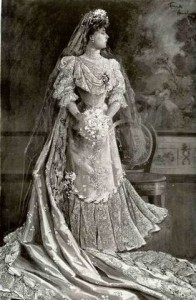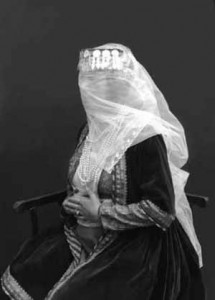People have been getting married for thousands of years, but brides haven’t always necessarily worn big white gowns, veils, or toss-away garters. So why do modern American brides dress the way they do for their weddings? What is the history of bridal attire and what is the meaning behind these wedding traditions?
Well, wedding gowns, at least, are pretty straightforward. A beautiful wedding dress not only shows the bride to her best advantage, but also conveys to all the guests – especially the groom and his family – the bride’s family’s wealth and respectability, and perhaps the bride’s skill with a needle if she made it herself (a valuable skill indeed prior to the mass production of clothing). A well-made dress was an easy way to communicate to everyone present how lucky the groom was to catch such a bride, and it could be said without a word.

But why is white considered a traditional wedding color? Most people assume that brides wear white to convey purity, particularly virginity, and that this is an ancient tradition. However, neither assumption is true. The first ever white wedding gown was worn b Anne of Brittany during her wedding to Louis XII of France but, the modern use of white wedding dresses only became popular when England’s Queen Victoria wore a white dress for her wedding to Prince Albert in 1840. She chose to get married in an elaborate white dress, perhaps in part because white cloth was so expensive. White wedding gowns then became fashionable among the upper classes (those who could afford yards and yards of delicate white fabric). However, as white cloth became more affordable over the next several decades, white became a more common color in wedding dresses. White’s popularity has never been so absolute as to prevent some brides from choosing more colorful gowns, though, and the use of color is a trend which is continuing to grow today, as fewer brides feel the need to conform with a tradition that (as it turns out) isn’t very old to begin with!
Today’s bridal garters are the modern equivalent of the more functional garters that were used to hold up stockings, and as such were an important part of the bride’s attire. An old tradition held that after the marriage ceremony, it was considered lucky to get an article of the bride’s clothing. An easy way to provide an article without tearing up the dress (or ending up with sagging stockings) was to have clothing items, like an easily removed non-functional garter, available to give to guests. A related tradition, in which it was the groom’s privilege to remove the garter from the bride and toss it to the guests, was a symbolic way of “deflowering” the bride and conveying to the guests that the bride was now his wife.

Veils have been used by women for thousands of years in many settings besides weddings. Wedding veils, however, have been used in a number of cultures for different reasons. Roman brides wore large, flame-colored veils to ward off evil spirits on the wedding day. Ancient Jewish brides wore veils as a symbol of modesty. The biblical Rebekah was said to have veiled herself prior to her meeting with her betrothed, Isaac, in order to convey her independence – that she would still be her own person even after her marriage to Isaac. Other cultures held that the lifting of the veil by the groom after the ceremony symbolized the groom taking possession of his wife.
Weddings have been happening for a long time, and since it is such an ancient human ritual, it seems right to most brides to have elements of tradition in their own weddings. Modern brides possess the considerable good fortune to have both the freedom and the challenge of choosing how much tradition to incorporate into their wedding, including their bridal clothing.
It’s helpful to know the origins of various wedding traditions so that brides can choose – even as the ancient Rebekah chose – to communicate exactly who they are and what they want to portray to their groom, guests, friends and family during one of the most important events of their lives.

